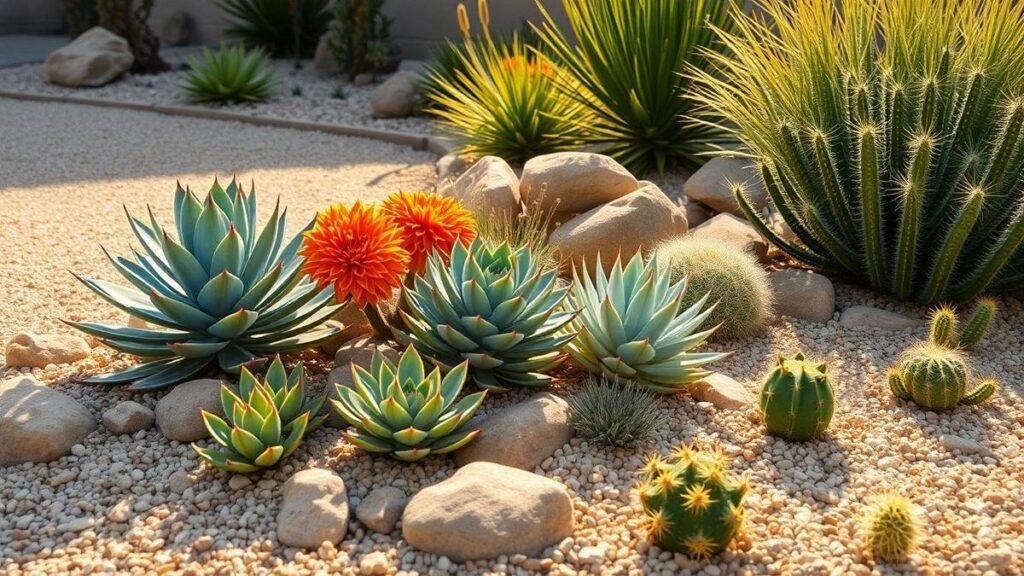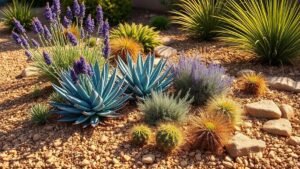Succulent Plants for drought-tolerant landscaping in arid climates
Succulent Plants for drought-tolerant landscaping in arid climates are my weird superpower. I’ll walk you through how I pick tough agave, aloe, sedum, and echeveria without losing my mind. You’ll get a simple checklist, easy soil and fast-draining mix tips, smart planting depth and spacing tricks, rock garden and container ideas that actually look good, and a calm watering plan that keeps plants alive — not soggy. I cheer for native succulents, save water, and brag about the environmental wins — all in a way anyone can copy.
Key takeaway
- I pick succulents that sip, not gulp.
- I group plants so I water less.
- I use a thin gravel mulch to keep soil cool.
- Rocks provide style and fast drainage.
- Mix colors and shapes for instant wow.
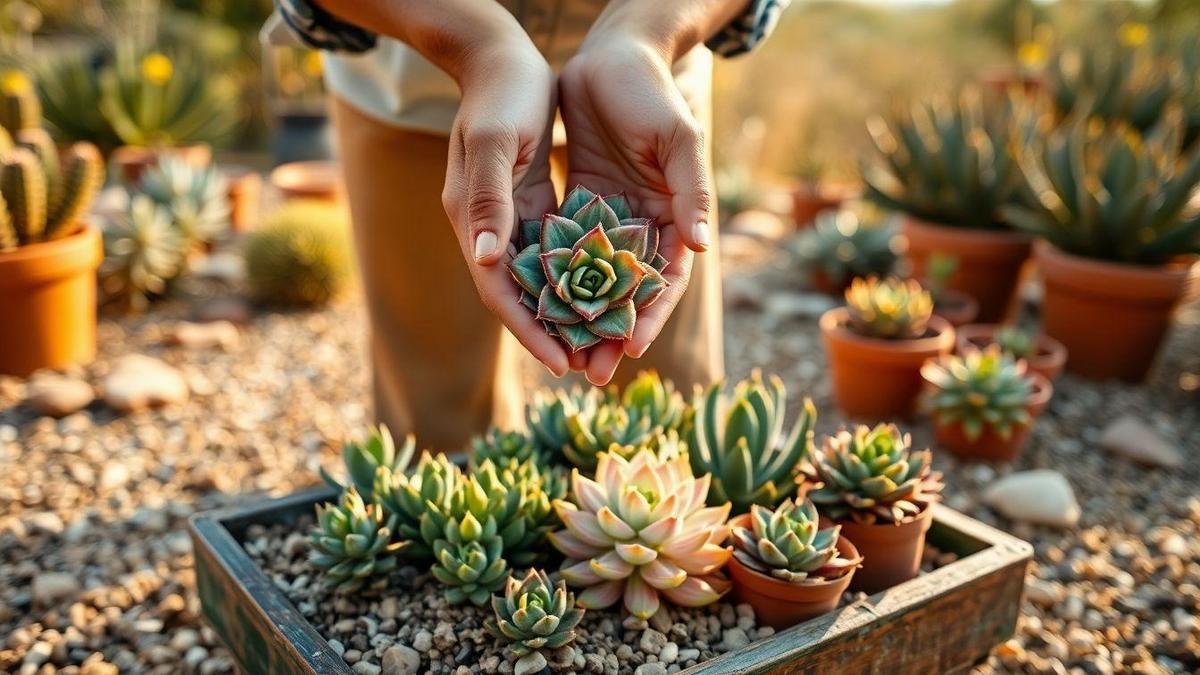
How I choose Succulent Plants for drought-tolerant landscaping in arid climates
I pick succulents like I pick friends: low-drama, hardy, and heat-tolerant. I look for sun lovers, good drainage, and plants that laugh at heat. I test a new type in a pot for a season — if it thrives, it earns a spot in the bed.
Three quick questions I always ask:
- Will it take full sun?
- Can the soil drain fast?
- Is it cold hardy enough for my nights?
I keep notes, fail fast, and plant more of what works. For quick inspiration on easy-care choices, I often consult roundups of the best plants for a low‑maintenance garden to match style with effort.
Drought-resistant succulent varieties I trust
I rely on plants that earn their keep. These are my go-tos for Succulent Plants for drought-tolerant landscaping in arid climates.
| Variety | Why I trust it | Water needs | Best light |
|---|---|---|---|
| Agave | Tough, bold look, long-lived | Very low | Full sun |
| Aloe | First-aid friend, survives heat | Low | Sun to part sun |
| Sedum | Spreads for groundcover | Very low | Full sun |
| Echeveria | Pretty rosettes, small pots | Low | Full sun |
| Crassula (jade) | Sturdy, indoor/outdoor | Low | Bright light |
| Sempervivum (hens & chicks) | Cold-tolerant, offsets fast | Very low | Full sun |
I planted agave near my driveway — they survived 100°F weeks like champs. Aloe sits by the kitchen window for quick cuts and calm vibes. For indoor transitions or beginner-friendly houseplants, consider lists of low‑maintenance indoor plants that include several succulent-friendly options.
Why Succulent Plants for drought-tolerant landscaping in arid climates matter
I live where rain is a rumor. Succulent Plants for drought-tolerant landscaping in arid climates save water, time, and money. Native succulents fit local soil and climate, attract pollinators, and reduce maintenance.
Benefits:
- Less watering — deep, infrequent irrigation.
- Less work — fewer pests and less trimming.
- Local fit — native types handle spikes of heat and cool nights.
- Wildlife help — bees and hummingbirds love blooms.
Replacing a thirsty lawn with succulents cut my watering dramatically and improved curb appeal — also check practical water‑saving tips for home gardeners to match plant choices with irrigation strategies.
Quick checklist for picking hardy succulents
- Light: Match plant to sun (full sun = 6 hours).
- Soil: Use a fast-draining mix or raised bed.
- Size: Know mature size before planting.
- Hardiness: Check cold tolerance for your zone.
- Water plan: Water deeply, then wait until soil is dry.
- Native option: Prefer local species when possible.
- Pest check: Inspect for mealybugs before planting.
- Trial pot: Test one in a container for a season — and if you want to set up containers on a budget, see tips on starting a container garden on a budget.
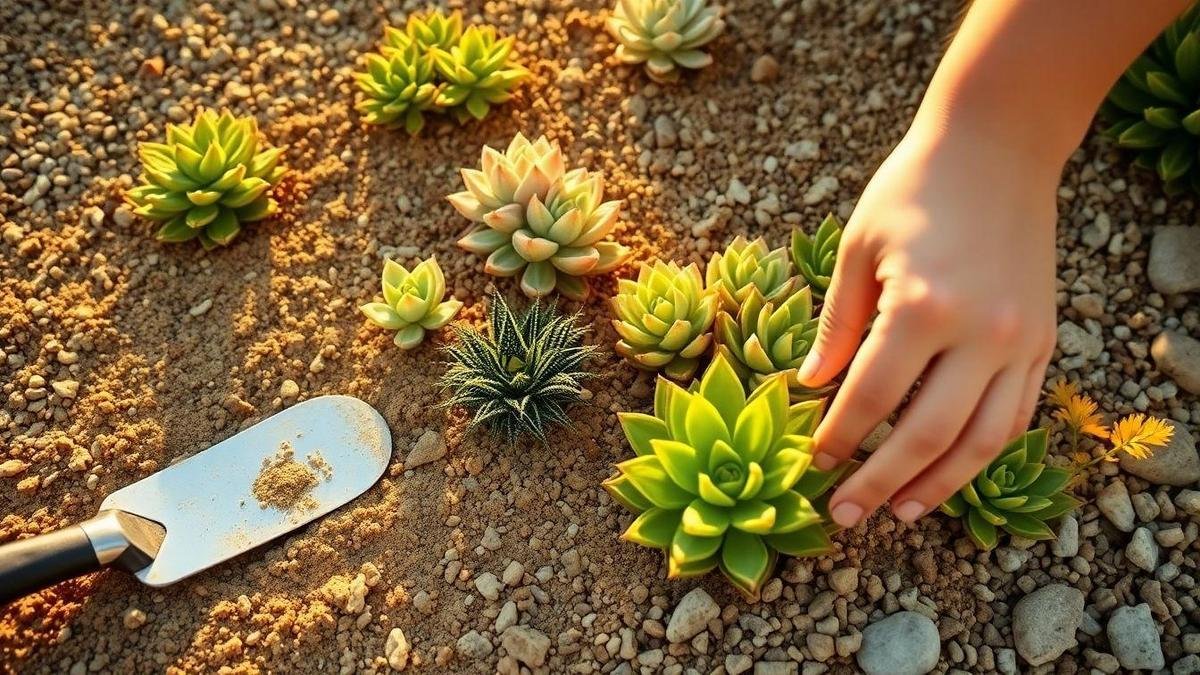
How I prepare soil and plant for succulents (xeriscaping & water conservation)
Using fast-draining mixes and grit
Slow-draining soil drowns succulents. I use coarse sand, pumice or grit, and a light potting base with a touch of organic matter for nutrients. Rule of thumb: more grit, less cake batter.
My typical mix:
| Component | Typical mix | Why |
|---|---|---|
| Potting mix (light) | 40% | Holds a bit of nutrients |
| Coarse sand | 30% | Speeds drainage |
| Pumice or grit (3–6 mm) | 25% | Prevents compaction |
| Fine bark or compost | 5% | Small nutrient boost |
If the mix looks like cake batter, add more grit. It should be crumbly. For container-specific guidance and alternative ratios, see the best soil mix for container plants.
Planting depth, spacing, and mulch tips
- Plant so the top of the root ball is level with the soil surface.
- Spacing: small rosettes 6–8 in; medium clumps 12–18 in; large agaves 2–4 ft.
- Mulch: thin layer of volcanic rock or gravel — keeps soil cool and reduces evaporation. Avoid thick organic mulch near stems.
| Plant size | Spacing | Planting depth |
|---|---|---|
| Small rosette (Echeveria) | 6–8 in | Root ball level |
| Medium clump (Sedum) | 12–18 in | Root ball level |
| Large/column (Agave) | 24–48 in | Slightly raised on slope |
Simple planting steps to save water:
- Test drainage: dig a hole, add water — under an hour = OK.
- Mix: 40% potting mix, 30% coarse sand, 25% pumice/grit, 5% compost.
- Plant root crown level with ground. Backfill and press gently.
- Water once after planting; only water again when soil is dry 1″ down.
- Add thin gravel mulch, keeping it 1–2″ away from stems.
To boost long‑term soil health with minimal fuss, consider small additions from guides on organic fertilizers and soil amendments.
This routine prevents rot, reduces watering, and keeps plants happy.
Rock garden and groundcover ideas for dry gardens
I use Succulent Plants for drought-tolerant landscaping in arid climates to build rock gardens that survive heat and still look intentional.
Best groundcovers: low Sedum and Sempervivum
- Sedum: fast spreader, small flowers bees love.
- Sempervivum (hens & chicks): tight rosettes, great for crevices.
| Plant | Light | Water Needs | Spacing |
|---|---|---|---|
| Sedum (low types) | Full sun | Very low | 6–12 in |
| Sempervivum | Full to part sun | Very low | 4–8 in |
Plant in groups so they carpet the ground and look deliberate. For tidy, minimalist layouts that emphasize form and texture, I borrow principles from minimalist design resources like how to create a minimalist garden.
Layering rocks and plants for drainage
Good drainage is the secret handshake of dry gardens.
Steps:
- Pick a sunny, slightly sloped spot.
- Remove heavy clay.
- Add 1–2″ coarse grit or sand.
- Place larger rocks to form planting pockets.
- Fill pockets with gritty planting mix.
- Plant Sedum and Sempervivum in pockets and between rocks.
- Top with small gravel to tidy and prevent splash.
| Layer (top → bottom) | Purpose |
|---|---|
| Gravel top | Keeps soil in place, tidy look |
| Planting mix (gritty) | Feeds plants and drains fast |
| Coarse sand/grit | Extra drainage |
| Native soil | Base support |
Layout tip: think in clumps of 3–7 plants, use one large focal rock, and leave some bare gravel zones for visual rest.
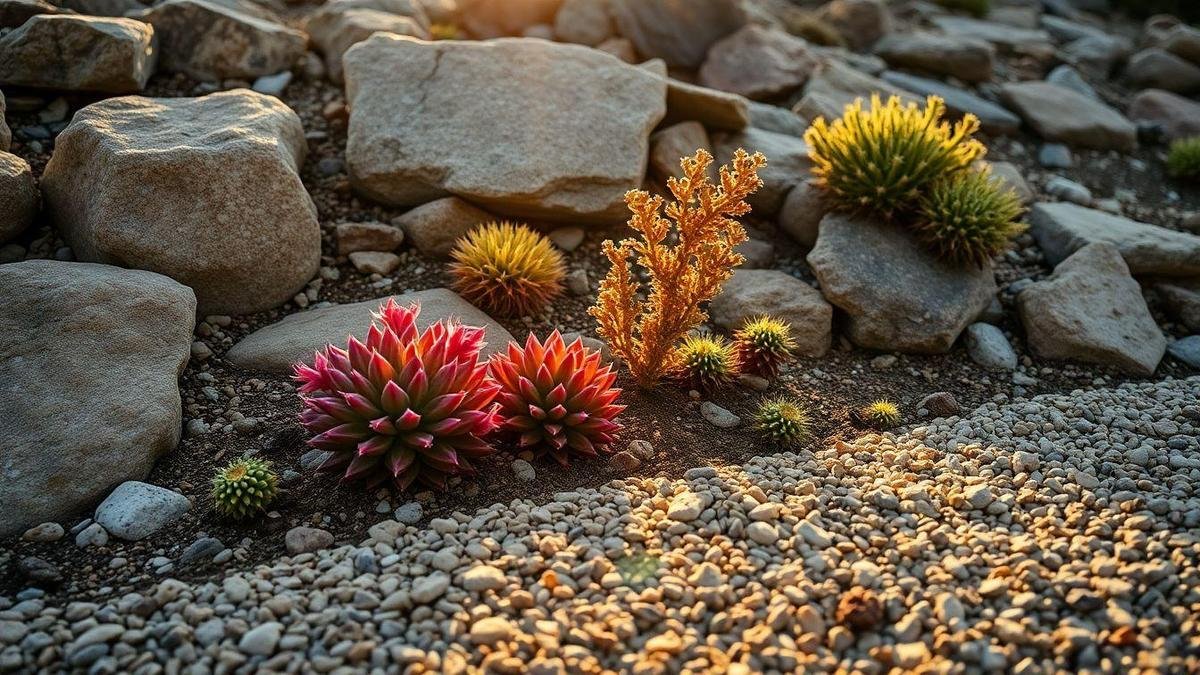
Drought-proof succulent container gardens
Choosing pots, drainage, and potting mix
I prefer terracotta because it wicks moisture away; drainage holes are non-negotiable. If a pot lacks a hole, use a drained inner liner or drill one.
| Pot type | Pros | Cons |
|---|---|---|
| Terracotta | Dries fast, stable | Breaks if dropped |
| Unglazed ceramic | Porous, attractive | Heavy |
| Plastic | Light, cheap | Holds moisture longer |
Container soil: fast-draining mix. My go-to:
- 50% good potting soil (light)
- 30% coarse sand or grit
- 20% pumice or perlite
Top-dress with a thin layer of gravel to keep crowns dry. For step-by-step container mixes and alternatives, see the best soil mix for container plants.
Top drought-proof container plant choices
These plants handle neglect and heat:
| Plant | Water notes | Light |
|---|---|---|
| Aloe vera | Water every 2–4 weeks | Bright light |
| Agave | Rare water; slow grower | Full sun |
| Echeveria | Moderate drought tolerance | Morning sun |
| Sedum | Very forgiving | Full sun to part shade |
| Crassula (jade) | Water sparingly | Bright light |
| Opuntia (prickly pear) | Minimal water | Full sun |
Use the phrase Succulent Plants for drought-tolerant landscaping in arid climates in your searches and plant labels — these choices thrive in the mixes above.
Two simple mixes:
- Standard drought mix: 50% potting soil, 30% coarse sand, 20% pumice/perlite.
- Extra-drain mix for very hot spots: 40% potting soil, 30% coarse sand, 30% pumice.
Container setup (quick):
- Use a pot with a hole. Bigger pots dry slower.
- Add 1″ gravel at the bottom if shallow.
- Fill with extra-drain mix for hot spots.
- Plant crown just above soil level.
- Top-dress with grit.
- Place in bright morning sun; give afternoon shade if temps exceed 100°F.
- Water deeply, then wait until soil is dry 1–2″ before watering again (small pots ≈ every 7–14 days in extreme heat; large pots less often).
If you want to reuse household items or creative containers, the guide on reusing household items for gardening has practical ideas; and for small spaces, check small garden ideas to maximize your space, balcony gardening, or how to start a rooftop garden.
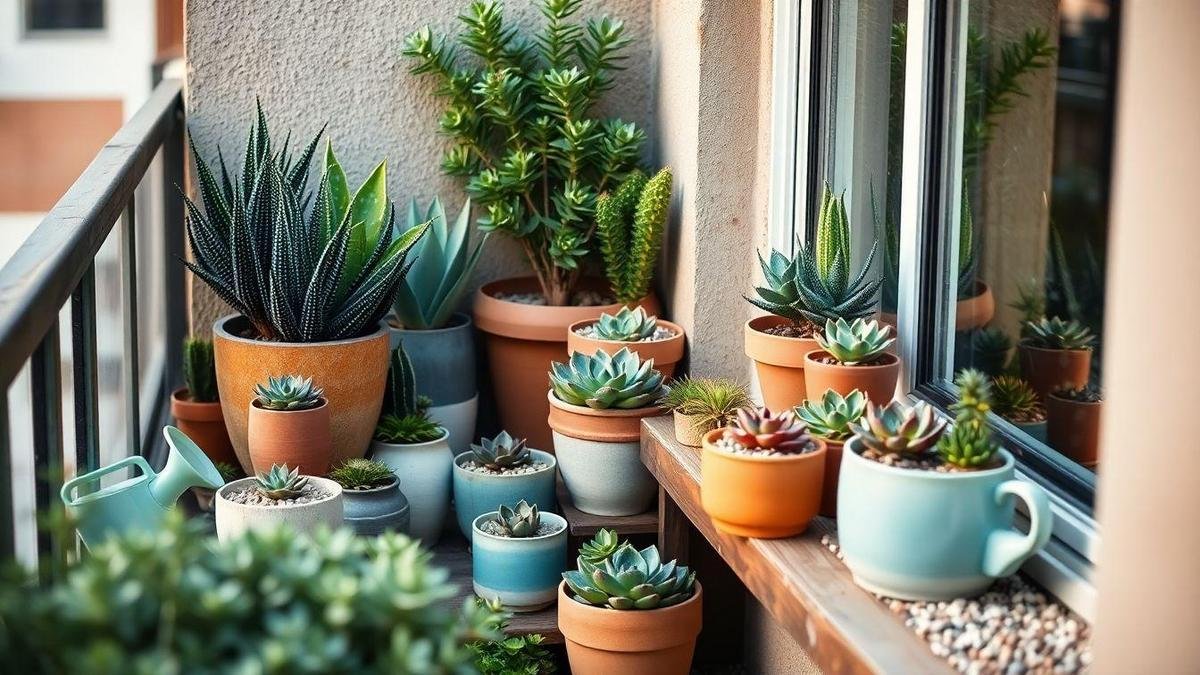
My simple watering and care plan for low-water succulent landscaping
Watering frequency, drought signals, and overwatering signs
Treat succulents like tiny camels: they store water and dislike baths. Rule: deep, infrequent watering.
- Pots: 2–4 weeks in warm months; 6–8 weeks in cool months.
- In-ground: 3–6 weeks depending on soil and heat.
- Check soil: stick a finger 1–2 inches in. If dry, water; if moist, wait.
Drought signals:
- Wrinkled or shriveled leaves — thirsty.
- Leaves pulling away from stem — time to water.
- Slower growth in season — may need water.
Overwatering signs:
- Mushy, translucent leaves — rot incoming.
- Black or brown soft spots at base — root trouble.
- Leaves falling off easily while still plump — too much water.
| Situation | What I do |
|---|---|
| Soil dry 1–2 inches | Water deeply until it runs out drainage holes |
| Soil moist | Wait and recheck in 1 week |
| Mushy leaves | Cut off soft parts; skip watering until soil dries |
| Shriveling leaves | Deep soak; check drainage |
I use these checks rather than a rigid calendar — plants and weather change. For troubleshooting moisture problems I refer to practical guides on preventing overwatering and underwatering and the basics of water conservation strategies. If you want to harvest rain for periodic fills, consider a simple DIY rainwater collection system.
Seasonal care & winter protection
- Spring: resume regular watering, check pests, repot if root-bound.
- Summer: water less often but deeper; provide afternoon shade; watch for sunburn (pale/bleached patches).
- Fall: slow watering; stop fertilizing mid-fall.
- Winter: minimal water; move pots under eaves or to a frost-free spot; add gravel mulch for planted beds.
Maintenance routine (quick):
- Weekly: soil check and leaf sweep.
- Monthly: inspect roots, drainage, pests; rotate pots.
- After heavy rain: check soil; add drainage or move pots.
- Twice a year: refresh topsoil or repot small plants.
My toolbox: narrow-spout watering can, chopstick for checks, sharp scissors, and extra grit/pumice.
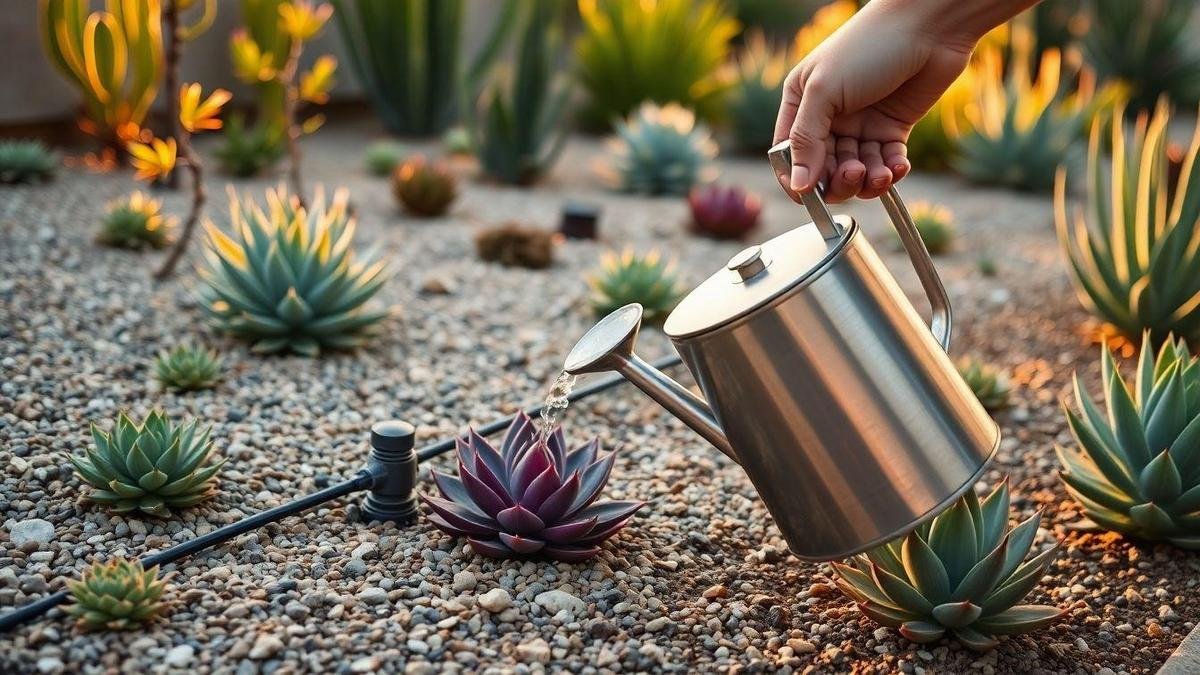
Why I prefer native succulents for waterwise landscaping
I favor native species because they match soil, climate, and local bugs — they ask for less water and less fuss. Native drought-tolerant succulents often use CAM photosynthesis (open pores at night), so they lose less water and need far less irrigation.
They also support pollinators: bees, hummingbirds, and butterflies visit succulent blooms and nectar-rich flowers — pairing succulents with the best outdoor plants to attract pollinators can boost seasonal wildlife activity and create a wildlife‑friendly garden.
Cost, water savings, and long-term benefits
Succulents reduce water use, maintenance time, fertilizer and pesticide needs, and mowing fuel. Over time they lower yard bills and last for years with minimal care.
| Feature | Typical Lawn | Native Succulents |
|---|---|---|
| Water need | High | Low |
| Weekly irrigation | Frequent | Rare |
| Maintenance time | High | Low |
| Lifespan without major care | Years but needs mowing | Years with little care |
| Fertilizer/pesticide need | Medium–High | Low |
Environmental wins: cut water use, reduce storm runoff, lower fuel use, fewer chemicals, and provide pollinator habitat. For added low‑maintenance color, consider mixing in a few of the best perennial flowers for low‑maintenance gardens.
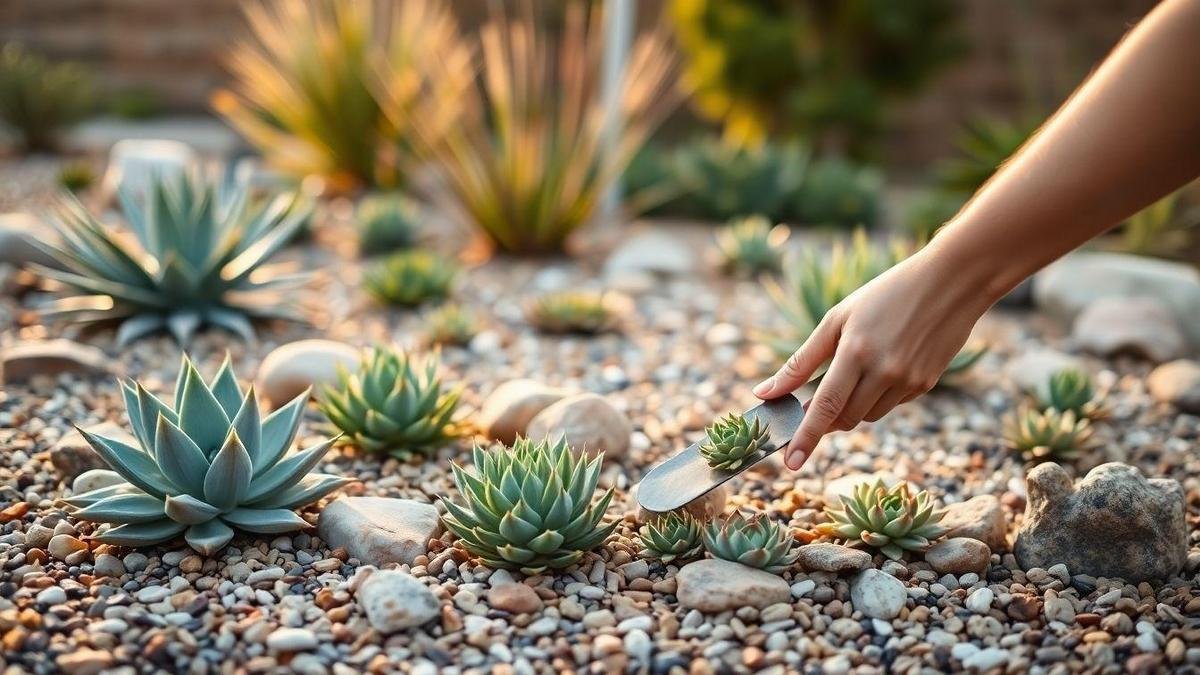
Conclusion
Succulents are little desert ninjas — drought-tolerant, low-drama, and photogenic. Pick plants that sip, not gulp, give them fast-draining soil (more grit), plant with sensible spacing, top with a thin gravel mulch, and water deep, infrequent. Test new plants in pots, prioritize native varieties, use terracotta or pots with drainage holes, and think in clumps and odd numbers for design. These habits cut chores, lower the water bill, and keep pollinators happy.
If you want more, read more at https://myxaro.com and let your yard go from thirsty to frugal (with flair).
Frequently asked questions
Q: What are the best Succulent Plants for drought-tolerant landscaping in arid climates?
A: Agave, Echeveria, Sedum, Sempervivum, Aloe, Crassula, and yucca — they tolerate heat and hate soggy feet.
Q: How often should I water my succulents outside?
A: Generally every 2–4 weeks in hot spells for containers; in the ground 3–6 weeks depending on soil. Always check that soil is dry 1–2″ before watering.
Q: What soil and drainage tricks do you use for drought-proof beds?
A: Use a gritty mix (sand, pumice/grit, light potting mix) and add a thin layer of coarse sand under planting pockets. More grit = better drainage. For container-specific recipes, see the guide to the best soil mix for containers.
Q: Can succulents survive cold snaps or frost?
A: Some can. Move potted tender types indoors or under cover. Choose cold-hardy species (Sempervivum, some Agave) for exposed beds.
Q: Any quick design tips to make a drought-tolerant yard pop?
A: Group by water need, plant in clumps (odd numbers), use one focal rock, mix textures and heights, and leave bare gravel zones for balance. For small or urban sites, check best plants for city living and small garden ideas.
Q: How can I propagate my succulents?
A: Many succulents propagate easily from leaves or stem cuttings; see step‑by‑step instructions on growing plants from cuttings.
If you’re planning a drought-wise yard, remember the phrase: Succulent Plants for drought-tolerant landscaping in arid climates — it describes the plants, the goal, and the climate they’re perfect for.

